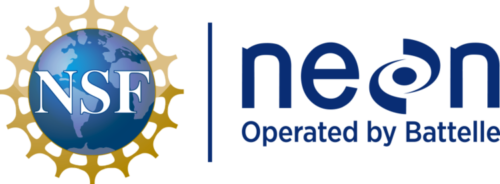Date: June 4, 2020
Post by: Kelsey Yule; Project Manager, NEON Biorepository and Nico Franz; Principal Investigator, NEON Biorepository

Background. The National Ecological Observatory Network (NEON; https://www.neonscience.org/) is known for producing and publishing 180 (and counting) data products that are openly available to both researchers and the greater public. These data products span scales: individual organisms to whole ecosystems, seconds to decades, and meters to across the continent. They are proving to be a central resource for addressing ecological forecasting challenges. Less well known, however, is that these data products are all either directly the result of or spatially and temporally linked to NEON sampling of physical biological (e.g. microbial, plant, animal) and environmental (e.g. soil, atmospheric deposition) samples at all 81 NEON sites.
The NEON Biorepository at Arizona State University (Tempe, AZ) curates and makes available for research the vast majority of these samples, which consist of over 60 types and number over 100,000 per year. Part of the ASU Biodiversity Knowledge Integration Center and located at the ASU Biocollections, the NEON Biorepository was initiated in late 2018 and has received nearly 200,000 samples to date (corresponding to some 850 identified taxa in our reference classification). Sampling strategies and preservation methods that have resulted in the catalog of NEON Biorepository samples have been designed to facilitate their use in large scale studies of the ecological and evolutionary responses of organisms to change. While many of these samples, such as pinned insects and herbarium vouchers, are characteristic of biocollections, others are atypical and meant to serve researchers who may not have previously considered using natural history collections. These unconventional samples include: environmental samples (e.g. ground belowground biomass and litterfall, particulate mass filters; tissue, blood, hair and fecal samples; DNA extractions; and bulk, unidentified community-level samples (e.g. bycatch from sampling for focal taxa, aquatic and terrestrial microbes). Within the overarching NEON program, examination of these freely available NEON Biorepository samples is the path to forecasting some phenomena, such as the spread of disease and invasive species in non-focal taxonomic groups.
Sample Use. Critically, the NEON Biorepository can be contrasted with many other biocollections in the allowable and encouraged range of sample uses. For example, some sample types are collected for the express purpose of generating important datasets through analyses that necessitate consumption and even occasionally full destruction. Those of us at the NEON Biorepository are working to expedite sample uptake as early and often as possible. While we hope to maintain a decadal sample time series, we also recognize that the data potential inherent within these samples needs to be unlocked quickly to be maximally useful for ecological forecasting and, therefore, to decision making.
Data portal. In addition to providing access to NEON samples, the NEON Biorepository publishes biodiversity data in several forms on the NEON Biorepository data portal (https://biorepo.neonscience.org/portal/index.php). Users can interact with this portal in several ways: learn more about NEON sample types and collection and preservation methods; search and map available samples; download sample data in the form of Darwin Core records; find sample-associated data collected by other researchers; explore other natural history collections’ data collected from NEON sites; initiate sample loan requests; read sample and data use policies; and contribute and publish their own value-added sample-associated data. While more rapidly publishable NEON field data will likely be a first stop for forecasting needs, the NEON Biorepository data portal will be the only source for data products arising from additional analyses of samples collated across different research groups.
Exploration of feasible forecasting collaborations. The NEON Biorepository faces both opportunities and challenges as it navigates its role in the ecological forecasting community. As unforeseen data needs arise, the NEON Biorepository will provide the only remaining physical records allowing us to measure relevant prior conditions. Yet, we are especially keen to collaboratively explore what kinds of forecasting challenges are possible to address now, particularly with regards to biodiversity and community level forecasts. And for those that are not possible now, what is missing and how can we collaborate to fill gaps in raw data and analytical methods? Responses to future forecasting challenges will be strengthened by understanding these parameters as soon as possible. We at the NEON Biorepository actively solicit inquiries by researchers motivated to tackle these opportunities, and our special relationship to NEON Biorepository data can facilitate these efforts. Please contact us with questions, suggestions, and ideas at biorepo@asu.edu.
